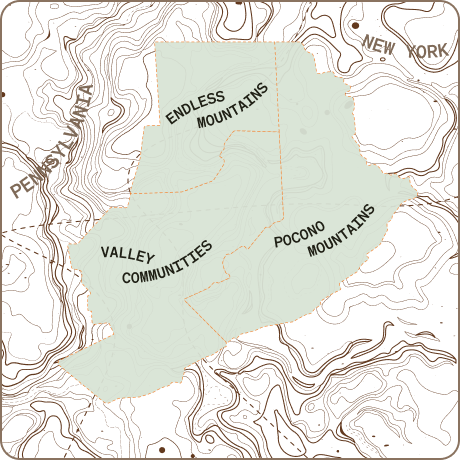North Branch Land Trust Plays Crucial Role in State’s Acquisition of 669-Acre Preserve
Governor Tom Wolf today announced the locations for three new parks that he’s adding to the now 121-state park system in Pennsylvania. The $45 million investment will create new recreational opportunities to meet the commonwealth’s high demand and conserve nearly 3,500-acres of vital natural and cultural resources.
The new state parks are Susquehanna Riverlands in York County, Vosburg Neck in Wyoming County, and Big Elk Creek in Chester County. The names are temporary, as final names for the state parks will be decided during the planning process.
“Our beautiful state parks are among the finest in the nation,” said Gov. Wolf. “I’m proud to have secured funding in my final budget to make this investment in our park system which will not only preserve invaluable natural resources and habitats for wildlife but provide in-demand access for Pennsylvanians to enjoy the beauty of nature and recreational opportunities.”
Including the addition of Washington Crossing to the state park system in 2016, Gov. Wolf has added four parks to the system during his eight years in office. This is more than any governor has added in the past 40 years.
In keeping with the state park selection process, each of the new locations has criteria that warrants conservation. The Vosburg Neck site will be Wyoming County’s first state park, while the Big Elk Creek location is under significant pressure from residential and commercial development. In York County, the Susquehanna Riverlands site adjoins and builds on large tracts of already preserved open space. Also, each site is within a half-hour of heavily populated areas where land for recreation use is often at a premium.
“Each new park site is unique in its value to a great system,” said Department of Conservation and Natural Resources (DCNR) Secretary Cindy Adams Dunn. “All of the new parks are steeped in cultural pre- and post-Colonial history, centered around important water resources and represent fantastic natural resource value.”
Including the investment in these three new state parks, Gov. Wolf made a historic $696 million investment in conservation, recreation, and preservation in his final budget.
Susquehanna Riverlands, York County
Susquehanna Riverlands in Hellam Township, York County includes 1,100 acres of natural resources. The largely wooded tract, located where Codorus Creek flows into the Susquehanna River, protects critical water and forest resources. The land was acquired with assistance from the Lancaster Conservancy and is adjacent to its Hellam Hills and Wizard Ranch nature preserves. Combined, they protect the last large wooded area along the Susquehanna River between the cities of Harrisburg, York, and Lancaster.
“By working side by side with DCNR, we are creating a conservation landscape that future generations will benefit from,” said Phil Wenger, president of Lancaster Conservancy. “Conservation needs both public and private organizations to partner to offset the impact increased development has on water and air quality, as well as ecological decline, to ensure our natural world doesn’t disappear before our eyes.”
Vosburg Neck, Wyoming County
Vosburg Neck is 669 acres being acquired with the assistance of the North Branch Land Trust. The park will offer scenic hiking opportunities, including a climb to an impressive westerly oriented vista, pleasant strolls along a former railroad bed, invigorating shared-use trails, and significant public access for water-based recreation to the North Branch of the Susquehanna River.
Big Elk Creek, Chester County
Big Elk Creek is 1,712 acres acquired through The Conservation Fund with the assistance of the Mt. Cuba Center and Chester County. It features 3.5 miles of Big Elk Creek, a tributary of the Elk River and the Chesapeake Bay. Big Elk Creek was an important transportation and natural resource corridor for indigenous people for thousands of years and an important area for freedom seekers on the Underground Railroad to the North.
The new parks are expected to be fully operational and ready to be enjoyed by the end of 2026. Find more information about Pennsylvania state parks on the DCNR website.






























